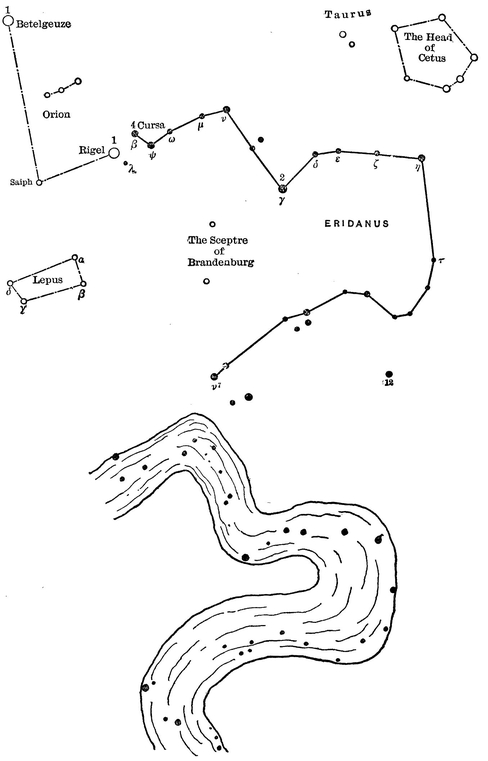Eridanus
The River Po

ERIDANUS
ERIDANUS
THE RIVER PO
The scorched waters of Eridanus’ tear-swollen flood
Welling beneath the left foot of Orion.
ARATOS.
ACCORDING to Eratosthenes this imaginary river of the stars, winding its devious way across the winter skies, represented the River Nile, and in the Alphonsine Tables it bore the title “Nilus.” Brown, however, claims that the Akkadians identified it with the River Euphrates, and that the name “Eridanus” may refer to a Turanian river name meaning “Strong River.”
In the Euphratean records there are many allusions to a stellar stream that may refer to this imaginary river, although there is a possibility that the Milky Way is intended, as that always represented a celestial river to the ancients.
Burritt tells us that Eridanus is the name of a celebrated river in Cisalpine Gaul, also called “Padus,” the modern “Po.” Virgil calls it “the King of Rivers,” and the Latin poets have rendered it famous from its connection with the fable of Phaeton, the intrepid youth who endeavoured to drive for a day the chariot of the sun. As the familiar story goes, he was unable to restrain the fiery steeds, and a universal catastrophe was only prevented by a timely thunderbolt from the hand of Jupiter, which hurled Phaeton from heaven into the River Eridanus.
At once from life and from the chariot driven,
The ambitious boy fell thunderstruck from heaven.
His body, consumed with fire, was found by the nymphs of the place, who honoured him with a decent burial. His sisters, the Heliades, mourned his unhappy end, and were changed by Jupiter into poplars, the trees that are found in great abundance in the valley of the Po.
All the long night their mournful watch they keep,
And all the day stand round the tomb and weep.
Ovid.
It is said that the tears of the Heliades were turned to amber. Apollonius represented the Argonauts as passing along the banks of the River Eridanus in their voyage from Ister to the Rhone, and as hearing the lament of the Heliades, and seeing their amber tears.
Amber was imported into Greece from the northern shores of the Adriatic, and it was naturally identified with the River Po, the great river of northern Italy.
It is also related that when Hercules went on his quest of the golden apples of Hesperides, he came to the River Eridanus, and enquired his way of the nymphs dwelling near-by.
Burritt thinks that the fable of Phaeton alludes to some extraordinary period of drought and heat which was experienced in a very remote time, and of which only this confused tradition has descended to later times.
The constellation Eridanus is so extended that it has been divided, for the sake of convenience, into a northern and southern stream. The former has its source near the first magnitude star Rigel, in the foot of Orion, and hence Eridanus has been sometimes called “the River of Orion.”
Maunder considers that if we regard Eridanus as representing the Flood, and the sacrifice of Andromeda a means to cause its abatement, then Eridanus would stand for the Great Deep of the Primeval Chaos, of which the sea monsters typified the indwelling principle.
The Arab name for this constellation was “Al-Nahr,” meaning the River, and the Arabs also imagined that the stars in this group represented ostriches, young and old, eggs, and egg-shells.
“The River Jordan,” “the Red Sea,” and “the River of the Judge” are other names for this famous stream, and it has been identified with Homer’s stream flowing around the earth, and sometimes bore the titles “Oceanus,” and “the River of Ocean.”
β Eridani, called by the Arabs “Cursa,” signifying a footstool, is the principal star in the constellation seen in these latitudes. It owes its name to its position close to the foot of the Giant Hunter Orion. The Chinese called this star “the Golden Well,” and it was regarded by the Arabs as an ostrich nest, a number of which are scattered through the constellation.
The star γ Eridani was called by the Arabs “Zamack,” meaning the “bright star of the boat.” This would seem to infer that some sort of a craft was supposed to traverse the stream, and might be an allusion to the Ark, if the stream was originally intended to represent the Flood, as many authorities think.
We have, then, in the constellation Eridanus the diverse representations of a river on which there is a boat, and a gathering place for ostriches, with their nests, eggs, and egg-shells in evidence. This confusion of stellar imagery is one of the features of constellational study, and is at first blush difficult to account for. It seems reasonable to suppose, however, that the art of stellar representation was not confined to any one country, or a particular tribe, and as the nomadic herdsmen travelled from place to place, they left in each a smattering of the star lore that was as much a part of their lives as a knowledge of flocks and herds. As they would in all likelihood see in the star groups whatever their individual fancy dictated, a diversity of representations would naturally follow, which accounts in part for the confusion of figures that a close study of the constellations reveals.
Eridanus is an inconspicuous constellation, but on a clear night in midwinter, when the moon is absent from the sky, the stream can be traced without difficulty, spreading out like a great horseshoe south and west of the well-known constellation Orion.